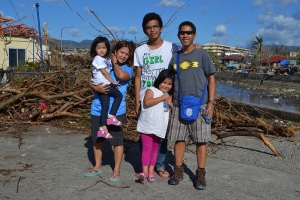
Packing aid a Church centre in Cebu for the worst hit communities in the Philippines. Credits: Carole Reckinger/Caritas Luxembourg
Caritas Germany have just ordered 10,000 shelters, hygiene kits and household kits for one of the worst hit islands of Leyte, due for delivery next week. Caritas member Catholic Relief Services (CRS) has chartered a 747 jet to transport 40,000 tarpaulins. A plane left Holland yesterday with 24 tonnes of tarps and 3300 medical kits from Caritas Netherlands (Cordaid).
The international Caritas relief effort is coordinated with the national Caritas and the local Church. Fr. Edwin Gariguez, Executive Secretary of Caritas Philippines-NASSA, has been part of an International Caritas Humanitarian Team on Leyte.
“We have never faced anything of this magnitude,” he said. “We greatly appreciate the support and solidarity from Caritas members around the world. By working together in a coordinated way, we can help save lives and rebuild communities.”
Catholic Relief Services will begin handing out 28,000 temporary shelters in the hard-hit Philippine city of Ormoc this weekend. The weatherproof tarpaulins will go to residents whose homes were destroyed by the typhoon.
The tarps, along with kits containing hygiene and household items, are coming by boat from Cebu City and will be stored in the gymnasium of a Catholic school as the distribution is organised.
Ormoc, a city of 190,000, is on the western side of Leyte, across a small range of mountains from the provincial capital Tacloban. Both cities experienced 13-foot tidal surges and devastating winds after Haiyan came ashore with winds approaching 200 mph. There are estimates that 90 percent of the structures in Ormoc were damaged or destroyed.
International Caritas Humanitarian Team member Eoghan Rice of Irish Caritas agency Trócaire said the situation in Ormoc is calm: “Boats are coming in with aid. There is a lot of helicopter activity. Assistance is arriving.”
The Caritas team has been able to travel to Tacloban and to other remote areas of Leyte. “From what I have seen, it’s a very calm situation,” he said. “People are waiting very peacefully for aid to arrive.”
He says that the same mild atmosphere is present at the docks, where 6000 people are queuing up to leave on ferries to nearby Cebu. In the queue for the boat, he met by chance a Philippine family with relations in his hometown of Dublin.

Rollie Baldesco with his wife Mapeth and children Karyl, Esme and Ellyza wait for a boat to take them from Leyte island to nearby Cebu. Credits: Eoghan Rice – Trócaire / Caritas
The need of aid in Tacloban is great. “Our house was ruined. We had no water. We were able to survive on some tinned food. We had to leave the city because we were afraid of disease as there are bodies on the street,” he said.
In addition to the Ormoc distribution, CRS plans to give shelters to residents of Palo on the eastern coast of Leyte about 10 miles south of Tacloban. Office space has been secured in Catholic church buildings there.
Caritas relief operations include a number of areas. “We’re trying to reach the devastated areas. But it’s still very difficult. There’s still no electricity or petrol, and no communications with people on the ground,” said Msgr Broderick Pabillo, Auxiliary Bishop of Manila, the President of Caritas Philippines (NASSA).
The Church has delivered eight truckloads of food packs, water, clothing and cash to the Archdiocese of Capiz, where tens of thousands of people are in need.
The Church has also opened a base in Calbayog to help reach people on Samar Island. Fr. Cesar Aculan, who is working on relief operations, said it will provide a critical staging area for emergency relief operations.
Significant Caritas relief operation began on 13 December there in support of the work being done by parishes.“Typhoon victims here in need food, they are already hungry,” said Fr. Aculan.
Fr. Neil Tenafrancia of the Diocese of Borongan said there is no let up in the Church and other organisation’s relief efforts but the fuel crisis limits their operations. “That’s our problem here because we remain isolated. Many roads were destroyed by the typhoon,” he said.
Msgr Broderick Pabillo says the people of the Philippines has shown great solidarity.
“Filipinos are willing to help the victims, with donations and also with prayers. Here in Manila many volunteers are preparing the aid parcels that are being sent to the disaster areas,” he said. “They’re also welcoming the survivors who’ve managed to get to Cebu and then Manila.”
All Catholic Church Masses in the Philippines for the following nine days will be offered for the dead and the grieving families they left behind.
